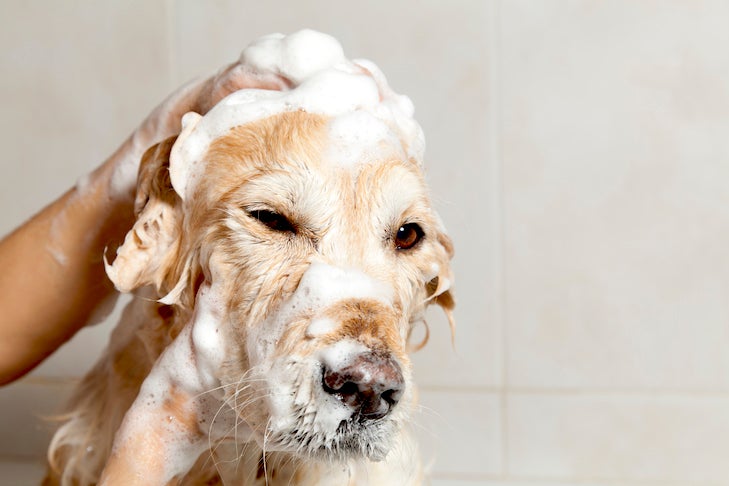
AKC is a participant in affiliate advertising programs designed to provide a means for sites to earn advertising fees by advertising and linking to akc.org. If you purchase a product through this article, we may receive a portion of the sale.
Any pet owner knows that dogs don’t mind being smelly and dirty. In fact, many dogs delight in rolling around in all sorts of substances we may think of as disgusting, or tearing through brush and mud puddles. At some point, your dog is going to need a bath. How to bathe your dog, and how often you should do so, depends on a few factors.
How Often Do Dogs Need a Bath?
Bath frequency depends on how much time your dog spends outdoors and what they do once they’re out there. But most experts recommend bathing as infrequently as possible to preserve natural oils and avoid drying out your dog’s skin. As a rule of thumb:
- Short-haired breeds, like Weimaraners or Beagles, need to be bathed less frequently.
- Oily-coated breeds, like Basset Hounds, may need a bath as often as once a week.
- Breeds (like Golden Retrievers) with water-repellent coats with a lot of natural oils should be bathed less often.

- Dogs with thick double coats, like the Alaskan Malamute, need fewer baths but a great deal of brushing.
Types of Dog Shampoo
Most important, do not use a shampoo meant for people, which doesn’t have the right pH level for dogs’ skin. There are many types of dog shampoo on the market, including:
- Natural or organic dog shampoos
- Heavy-duty dog shampoos and dry shampoos
- Oatmeal shampoos (some groomers recommend these for pets with itchy skin)
- Antifungal and antiseptic dog shampoos
- Flea and tick shampoos
Tips for Bathing Your Dog
- Brush your dog thoroughly before washing to remove loose hair, dirt, and other debris.
- You’re going to get wet, so dress accordingly.
- Gather everything you need, dog included. This includes shampoo, a washing brush (if you’re using one) or a washcloth, towels (many dog towels), cotton balls, and mineral oil.
- After making sure the water is warm, but not hot, put your dog in the tub or washbasin and fill it about knee-high.
- Protect your dog’s eyes with a few drops of mineral oil and put cotton balls in their ears to keep out water.
- A detachable shower spray nozzle makes bathing much easier. If you don’t have one, use a large container, like a pitcher.

- Wet your dog and then lather them with shampoo, working the soap through to the skin. Some pet owners start at the rear and work towards the front, washing the dog’s head last. Others prefer to do the reverse.
- If your dog has long hair, work the lather in the same direction as the coat grows. This will help avoid tangles later on. A rubber washing brush works well on dogs with short hair.
- Make sure to wash everywhere—belly, under the tail, legs and paws, under the neck, and around the ears.
- Rinse your dog gently with warm water, starting at the head and face. This may take patience since you want to remove all traces of the shampoo.
- You know with certainty that they’ll shake himself off rigorously after this, so you might want to stand back a bit. Then, rub your pet vigorously with a towel, or three, to get them as dry as you can. Some owners like to use a blow dryer on their dogs to dry them more thoroughly. If you do, don’t use the hottest setting on the dryer, and hold it at least one foot away so you don’t burn the skin. Then let your dog hang out in a warm, sunny room until they’re completely dry.
Aside from being a necessary part of grooming, bathing your dog can be a bonding and trust-building experience. It’s messy and time-consuming, but it can also be an enjoyable time spent with your canine pal.
 This article originally appeared in the award-winning AKC Family Dog magazine. Subscribe today!
This article originally appeared in the award-winning AKC Family Dog magazine. Subscribe today!
This article is intended solely as general guidance, and does not constitute health or other professional advice. Individual situations and applicable laws vary by jurisdiction, and you are encouraged to obtain appropriate advice from qualified professionals in the applicable jurisdictions. We make no representations or warranties concerning any course of action taken by any person following or otherwise using the information offered or provided in this article, including any such information associated with and provided in connection with third-party products, and we will not be liable for any direct, indirect, consequential, special, exemplary or other damages that may result, including but not limited to economic loss, injury, illness or death.

